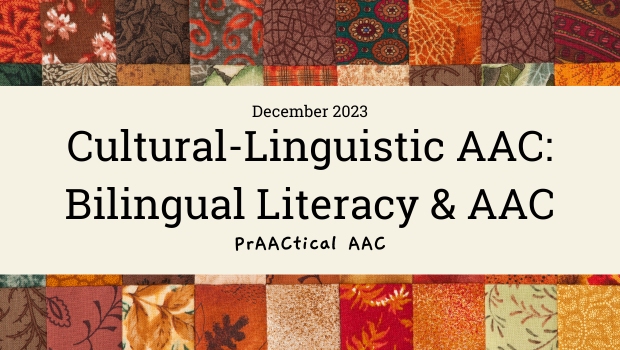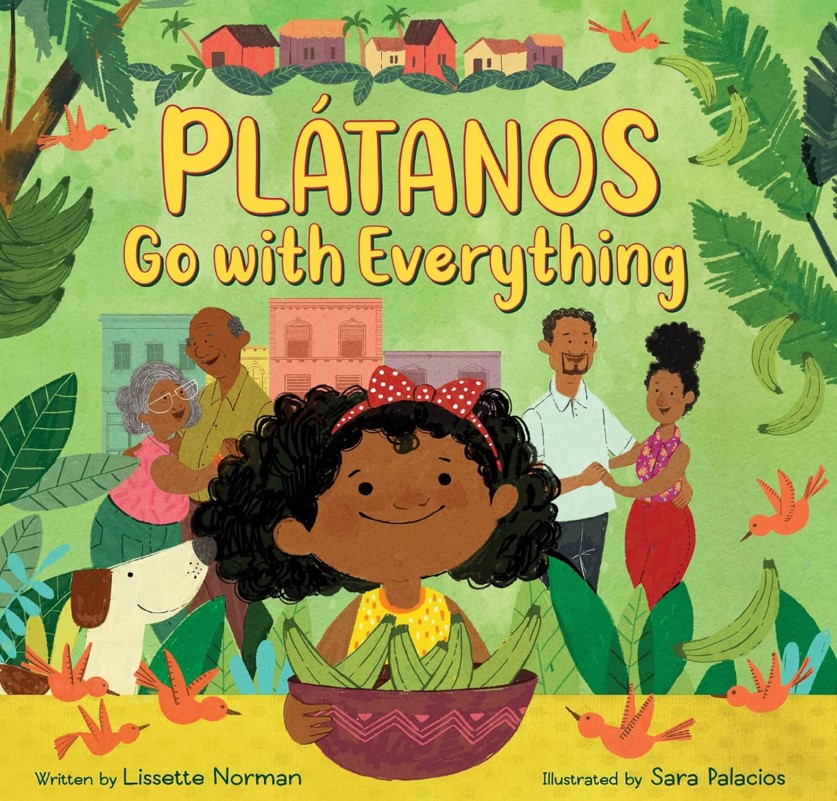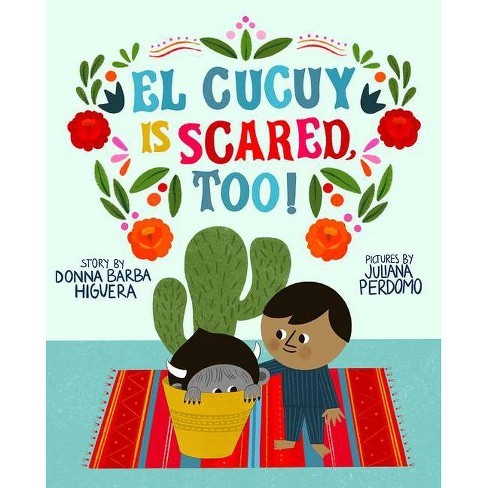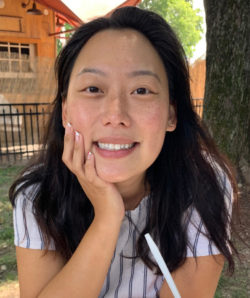Cultural-Linguistic AAC: Bilingual Literacy & AAC

Our yearlong series on multilingual AAC support, guest-authored by BilingüeAAC, is drawing to a close. In today’s post, Melissa Tapia and Sarah Lee address AAC, bilingualism, and literacy. BilingüeAAC is a group of SLPs with a shared belief in providing evidence-based intervention strategies and resources to bilingual Spanish AAC clients, families, caregivers, and professionals.
:::::::::::::::::::::::::::::::::::::::::::::::::::::::::::::::::::::::::::::::::::::::::::::::::::::::
Bilingual Literacy & AAC
Welcome back to our Bilingue AAC Series! You can find our previous posts linked here, which wonderfully highlight best practices in bilingualism and AAC. (Post 1, Post 2, Post 3, Post 4, Post 5).
We are excited to dive into our topic of bilingualism, literacy, and AAC and how we can effectively provide literacy intervention in culturally affirming ways with our Bilingual* AAC users.
*Clarification: We address “bilingual populations”; however, the resources discussed are specifically for Spanish/English speaking populations. Several of the suggestions can be broadly applied to other languages. The goal in bilingualism and biliteracy is promoting inclusivity and representation that allow for translanguaging.
What is literacy?
- The ability to read and write (ASHA, 2023).
- Reading is interpreting and understanding written information.
- Writing is the ultimate form of autonomous communication for all, as individuals can create their own messages. (see Karen Erickson and David Koppenhaver, Comprehensive Literacy for All)
- Important across the lifespan and settings – school, work, and home.
- Essential to individuals with complex communication needs who are AAC users.
What do we know about bilingualism?
- Failure to include long-term development and maintenance of both languages for bilingual children limits opportunities to practice and generalize linguistic skills across contexts and hinders interpersonal relationships with family members (Soto & Yu, 2014).
- The Cognate Advantage:
- Cognates are defined as words that share form and meaning in two languages (e.g., helicopter-helicóptero) (Kelley & Kohner, 2011).
- Spanish and English have more than 20,000 cognate pairs. More than half of the words in Beck et al., (2002,2008) Tier 2 vocabulary list were Spanish-English cognates (Montelongo et al., 2015).
- By leaning into the cognate vocabulary pairs, it will build upon the child’s existing knowledge necessary for academic success, encouraging bilingual and bi-literacy growth (Hernández, Montelongo, & Herter, 2016).
- The cognate advantage is seen in typically developing children (Kelley & Kohner, 2011; Leacox, Wood, Sunderman, & Schatschneider, 2016; Anthony, Blumenfeld, Potapova & Pruitt-Lord, 2020), children with SLI and children with developmental language disorder (DLD) (Grasso, Peña, Bedore, Hixon, & Griffen, 2018; Payesteh & Pham, 2022).
- Translanguaging:
- The strategic use of all linguistic resources to communicate (García, 2014).
- Translanguaging is more than rule-governed languages that we are switching across, but going beyond language and including a, “whole-body sense-making process” – the sights, the sounds, the features, the objects, and instruments, and how these are deployed (Garcia & Sánchez, 2020).
- It includes the individuals’ histories, biographies, and language practices (Cioé-Peña, Linares, 2020).
- Translanguaging has been found in bilingual elementary school students while writing (Bauer, et al., 2017; Velasco & García, 2014)
- Amongst 1st graders in pre-writing planning discussions (Gort, 2012)
- Considered a beneficial instructional strategy to improve reading comprehension and engagement (Daniel & Pacheco, 2016; Jiménez et al., 2015).
* A reminder: English core vocabulary or “high-frequency words” are not the same in Spanish or many other languages. Refer to Soto & Cooper (2021) or Macarthur Bates for a more comprehensive and developmentally appropriate list.
Bilingualism and Bi-literacy with a socioemotional lens
- Promoting a child’s heritage language is developing a sense of ownership over their linguistic repertoires and their voices as multilingual authors and storytellers
- Gaining access and connection to their families and communities
- Recognizing caregiver and child bonding as valuable
- Provides self-empowerment and autonomy in their world (Cioé-Peña, Linares, 2020.)
- Culturally responsive and equitable work includes the family’s culture, perspectives, language, intervention strategies, and so much more!
The intersections
- Do bilingual children have the same access as their monolingual peers?
- Do AAC users have the same access to early literacy as compared to typically developing communicators?
- Do Disabled children have the same access as their typically developing communicators?
NO 🙁
AAC users, or children who rely on AAC, tend to have limited access to materials with print and fewer opportunities to engage in “writing” (Light & Kent-Walsh, 2003).
Given all this information, we can see how there are literacy-based access and opportunity barriers for our bilingual AAC users.
Well, Bilingue AAC is here to provide you with some of our favorite bilingual book titles and inclusive AAC literacy intervention strategies that can help you navigate these barriers your current AAC users may have!
- Select appropriate bilingual book titles that amplify the voices of your student’s culture.
- Using bilingual books can promote cultural awareness, deepen and broaden vocabulary in both languages and create an inclusive space where all students feel valued.
- Create environments in which your students can observe and participate in shared storybook reading.
- Have pre-stored messages from books available on high-tech devices
- Use core boards available for a given literacy lesson
- Create opportunities for students to expand on their ideas through writing conventionally or with adapted methods.
- Whiteboards available for quick phonics demonstrations
- Keyboards available on high-tech devices
- Alternative adapted pencils, such as symbol-based icons, multiple single-button voice output communication devices to provide response options. For example, which letter sounds like/b/? VOCA recordings: “B” or “C”?)
- Review vocabulary and explicitly identify Spanish-English cognates
- Pre-reading, previewing, or “story walk,” and discussing the shared vocabulary.
- Identify the vocabulary in the AAC device in both language overlays.
- Here is a cognate vocabulary list by Colorín Colorado.
- Review Spanish high-frequency words. Here is a vocabulary list with suggested prompts and examples of Spanish sentence structure and conjugations.
- Include photos, objects, families, and their culture throughout the school and classroom setting.
- Provide both languages in written text throughout the room (i.e., numbers, alphabets, materials, etc.)
Books we love:
A heartwarming tale of all the ways you can eat and share Platanos from the perspective and voice of a Dominican-American girl in NYC. I love the vibrant colors and pictures of her family, friends, and community. Spanish and English text are both available.
What I do:
- Pre-reading vocabulary identification: help/ayudo, ingredient/ingrediente (cognate), eat/comer, platanos, like/me gusta, sweet/dulce, party/fiesta, more/mas, buy/comprar, see/veo, favorite/favorito (cognate).
- AAC vocabulary customization: Refer to post 4 for more culturally affirming ways to customize AAC systems.
- Story walk: Comment on the pictures. Model AAC device vocabulary.
- Discussion question: What is your favorite food? Is there a food you like to eat with your family?
- Shared book reading: Comment, ask questions, respond/expand.
- Predictable chart writing: I like to eat ______. Quiero comer ____________.
- Connection to the world and self: Bring in platanos – describe platanos (color, shape, texture). Show images of maduros, tostones, mangú. How would you eat it? Take a vote (math skills–tally). Cooking activity: Make maduras.
- Family/community follow-up: We read “Platanos Go with Everything” and learned about the different ways to eat platanos. Do you have a favorite family food you would like to share with the class?
 Ramón is in a new home and is scared about starting a new school and being new, and it turns out, El Cucuy is, too. This story, rooted in Mexican folklore, involves El Cucuy (a monster) and a little boy, Ramón as they begin a new journey in new unexpected places. The author wonderfully disperses Spanish words throughout the text in this dual-language print.
Ramón is in a new home and is scared about starting a new school and being new, and it turns out, El Cucuy is, too. This story, rooted in Mexican folklore, involves El Cucuy (a monster) and a little boy, Ramón as they begin a new journey in new unexpected places. The author wonderfully disperses Spanish words throughout the text in this dual-language print.
Literacy Activity ideas:
- Pre-reading vocabulary identification: Stop and discuss translanguaging in the text. (e.g., ‘That word is in Spanish and that one is in English.’)
- AAC vocabulary customization: Refer to post 4 for more culturally affirming ways to customize AAC systems.
- Story walk: Comment on the pictures. Model AAC device vocabulary. Describe what you see. What does it look like? What does it do?
- Discussion question: What is something new you tried? What helps you when you feel scared?
- Shared book reading: Comment, ask questions, respond/expand.
- Predictable chart writing: I feel ______. Me siento __________.
- Family/community follow-up: We read “El Cucuy is Scared Too.” We reviewed the following vocabulary [brave/Valiente, strong/fuerte, nervous/nervioso, scared/asustado]
Can you share with the class a time your family tried something new that required bravery?
(sleeping in your own room, moving to a new town, learning a new language)
You can do it! Take a dive into bilingual literacy with AAC users! Not sure where you can find more appropriate texts? Check out Colorín Colorado’s website for more book recommendations.
Check out local libraries and find texts written by authors who represent the language.
Colorin Colorado Books for Kids
Check out our website at BilingueAAC.com for suggested Spanish-English children’s books!
:::::::::::::::::::::::::::::::::::::::::::::::::::::::::::::::::::::::::::::::::
About the Guest Authors

Sarah Lee is a monolingual Speech-Language Pathologist certified in NY, CA, and Or. She has worked within school and early intervention settings across all 3 states specializing in AAC. She has a Master’s of Science in Speech-Language Pathology from Western Kentucky University and a Master’s of Science in Neuroscience and Education from Teacher’s College, Columbia University. Sarah believes in evidence-based, innovative intervention strategies and synthesizing literature to practice. She manages the Instagram account, @AAC_together.
 Melissa Tapia is a bicultural and bilingual Speech-Language Pathologist in Illinois. She attended Illinois State University for both undergraduate and graduate studies, majoring in Communication Sciences and Disorders and Spanish Language, Literature, and Cultures. Melissa is the owner and founder of Hablame Speech Therapy. She focuses on a client-centered collaborative model with bilingual families through in-home therapy services. She believes in helping AAC users gain access to communication in their immediate and most comfortable environment using various communication modalities and educating caregivers in how to best support their children together. Melissa manages the Instagram account, @hablame_de_language.
Melissa Tapia is a bicultural and bilingual Speech-Language Pathologist in Illinois. She attended Illinois State University for both undergraduate and graduate studies, majoring in Communication Sciences and Disorders and Spanish Language, Literature, and Cultures. Melissa is the owner and founder of Hablame Speech Therapy. She focuses on a client-centered collaborative model with bilingual families through in-home therapy services. She believes in helping AAC users gain access to communication in their immediate and most comfortable environment using various communication modalities and educating caregivers in how to best support their children together. Melissa manages the Instagram account, @hablame_de_language.
BilingüeAAC: www.BilingueAAC.com
Instagram: @bilingueaac
Facebook Group: BilingüeAAC
TPT: BilingueAAC
Filed under: Featured Posts
This post was written by Carole Zangari
